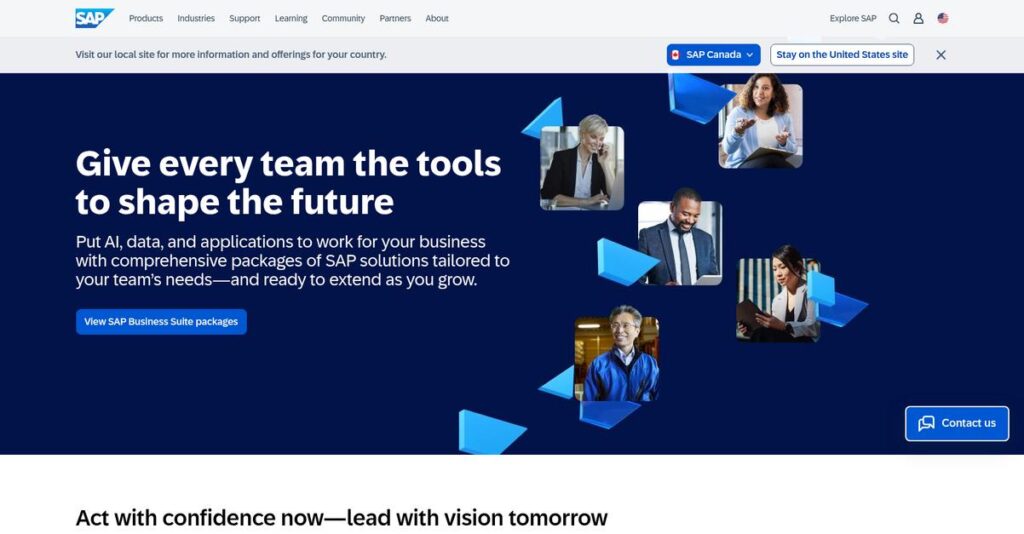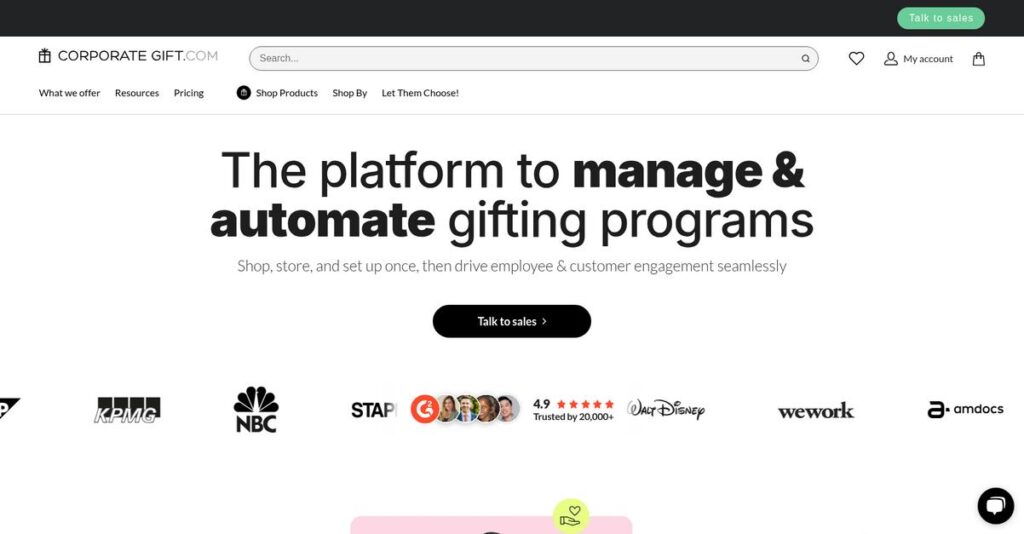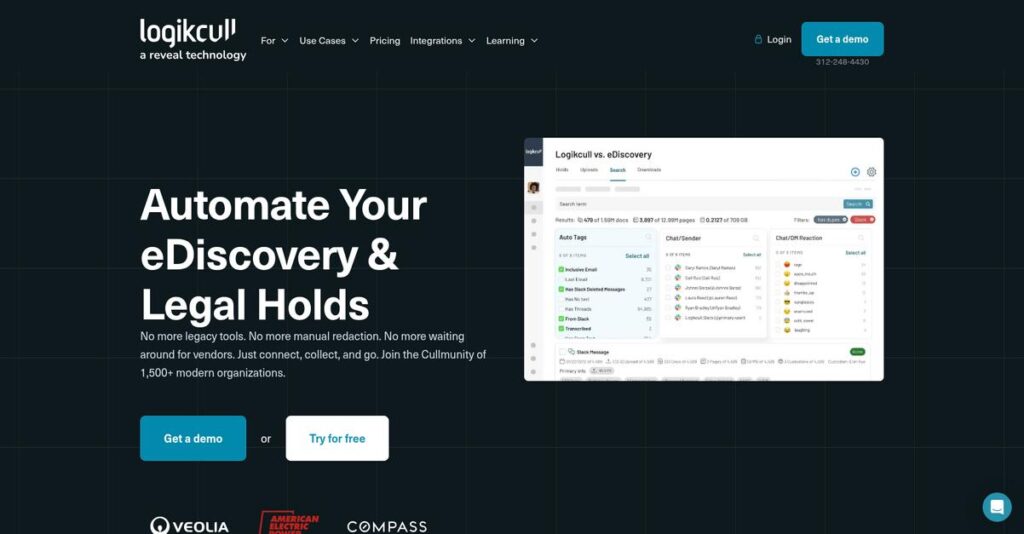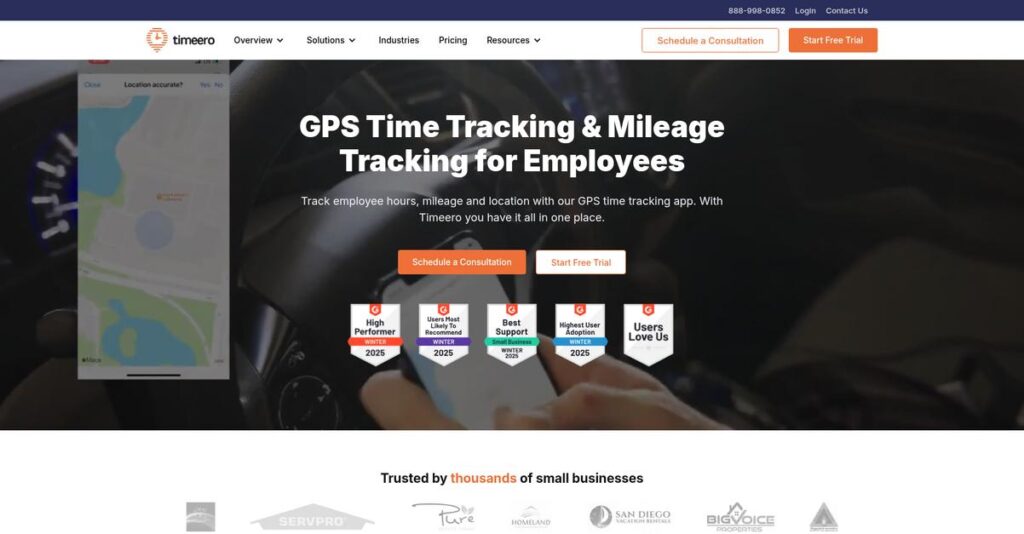Disconnected data slowing your business down?
If you’re evaluating ERP and business management tools, you already know how tough it is to wrangle scattered systems, slow reporting, and manual processes as your company grows.
The real pain is obvious—it’s wasted hours every day hunting for accurate numbers and struggling just to keep operations coordinated.
SAP takes these problems head on with its integrated suite built around S/4HANA, letting you connect finance, HR, supply chain, and data analytics in real time. Unlike patchwork alternatives, SAP aims to give you one platform for every part of your operation—even across multiple countries and business units.
In this review, I’ll break down how SAP actually helps unify your business operations so you can focus more on decision-making and less on data wrangling.
You’ll find a detailed SAP review of features, real-world advantages, pricing details, and the main alternatives—all with practical insights for your evaluation process.
By the end, you’ll know exactly which features you need to boost confidence in your software decision.
Let’s dive into the analysis.
Quick Summary
- SAP is a comprehensive enterprise software provider offering ERP, HCM, CRM, and supply chain solutions focused on integrated, real-time business management.
- Best for mid-market and large enterprises managing complex global operations and requiring deep process integration.
- You’ll appreciate its real-time data insights and extensive customization that support complex transactions and scalable workflows.
- SAP offers tailored enterprise pricing with no widely available free trial, typically requiring direct contact for demos and quotes.
SAP Overview
SAP has been a titan in enterprise software since its 1972 founding in Germany. Their core mission has always been helping complex global businesses run their critical operations more effectively.
They focus on large enterprises and upper mid-market companies with demanding operational requirements. What really sets them apart is their deep expertise in specific industries, providing robust, tailored solutions for your unique business needs.
You can’t miss their huge push to the cloud with S/4HANA and BTP, a key development I will break down further through this SAP review.
While competitors champion a pure cloud-native approach, I find SAP’s true value is its unmatched business process intelligence embedded right into the software, something they have painstakingly refined over five decades.
They work with the biggest names in manufacturing, retail, and public services—organizations where operational precision and regulatory compliance are absolutely critical for survival.
From my perspective, their entire strategy is about helping you migrate powerful, time-tested business workflows into a modern cloud architecture, so you can gain agility without sacrificing mission-critical stability.
Now let’s examine their core capabilities.
SAP Features
Are disparate business systems holding you back?
SAP solutions are designed to integrate critical business functions across your entire enterprise. These are the five core SAP solutions that address complex operational challenges.
1. SAP S/4HANA (ERP)
Still wrestling with slow, disconnected data?
Traditional ERPs often struggle with real-time insights, leading to delayed decisions and inefficient operations. This fragmented view can severely impact your agility.
SAP S/4HANA acts as your digital core, providing real-time data across finance, supply chain, and operations. From my testing, its in-memory computing capabilities are impressively fast, leveraging AI and machine learning. This solution ensures you have immediate visibility into every aspect of your business, from inventory to sales.
What you get instead is rapid decision-making and optimized performance across your entire organization.
2. SAP SuccessFactors (Human Capital Management)
Is your HR department overwhelmed by manual processes?
Inefficient HR operations, from recruitment to talent development, can hinder employee satisfaction and workforce effectiveness. This creates unnecessary administrative burdens for your team.
SuccessFactors streamlines the entire employee lifecycle, offering comprehensive cloud-based HR solutions. Here’s what I found: its intuitive interface improves employee experience with self-service options. This solution also leverages AI for predictive analytics, helping you identify skill gaps and recommend learning paths automatically.
This means you can transform your HR processes, leading to better employee engagement and data-driven workforce strategies.
- 🎯 Bonus Resource: While we’re discussing business operations, understanding Construction CRM Software is equally important for project success.
3. SAP Ariba (Procurement and Supply Chain)
Tired of uncontrolled spending and limited supplier visibility?
Manual procurement processes often lead to inefficiencies, inflated costs, and a lack of transparency in your supply chain. This makes managing vendor relationships incredibly difficult.
SAP Ariba digitizes your source-to-settle process, connecting you with a global network of suppliers. What I love about this approach is how it streamlines purchasing, contracts, and payments. This feature facilitates seamless collaboration with third-party vendors through user-friendly portals, providing end-to-end visibility.
The result is greater cost savings, improved compliance, and stronger supplier relationships for your business.
4. SAP Customer Experience (CX)
Struggling to provide a unified customer experience?
Fragmented customer data and inconsistent interactions across touchpoints can frustrate your customers and erode loyalty. This makes delivering personalized service almost impossible.
SAP CX consolidates customer interactions, providing a holistic view of your customer journey. From my testing, this suite seamlessly integrates with your ERP data, allowing for highly personalized engagements. It helps you gather comprehensive customer data, ensuring tailored services and enhanced customer satisfaction.
This means you can improve customer engagement, foster loyalty, and gain actionable insights from unified customer information.
5. SAP Business Technology Platform (BTP)
Are data silos and complex integrations slowing innovation?
Disconnected systems and the inability to quickly develop custom applications can stifle innovation and hinder digital transformation efforts. This makes your infrastructure rigid.
SAP BTP acts as an integrated cloud platform for data management, analytics, and application development. From my evaluation, its low-code/no-code tools enable rapid app creation. This solution connects your SAP and third-party systems, enabling seamless data flow and intelligent automation for improved operational efficiency.
So you get faster decision-making, flexible system integration, and significant productivity gains across your operations.
Pros & Cons
- ✅ Provides comprehensive, integrated solutions for large enterprises.
- ✅ Offers powerful real-time data and analytics for fast decisions.
- ✅ Strong ecosystem with extensive third-party integrations via BTP.
- ⚠️ Can be complex with a steep learning curve for new users.
- ⚠️ Implementation often requires significant time and external expertise.
- ⚠️ User interface sometimes perceived as less intuitive or dated.
These SAP solutions work together to create a powerful and integrated enterprise ecosystem, centralizing your business processes for improved efficiency and insight.
SAP Pricing
Unsure what your SAP investment truly means?
SAP pricing relies on a custom-quote model, reflecting its enterprise focus and requiring direct contact for specific cost details, which helps you get a solution tailored to your exact needs.
Cost Breakdown
- Base Platform: Custom quote (Contact sales)
- User Licenses: Starting from $75 per user per month (for specific modules like SAP CRM)
- Implementation: Significant variable cost; complex due to customization
- Integrations: Varies by complexity; often via SAP BTP
- Key Factors: Number of users, modules selected, level of customization, deployment (cloud/on-premise)
1. Pricing Model & Cost Factors
Understanding SAP’s cost drivers.
SAP’s pricing model is inherently customized, meaning there aren’t fixed tiers for core products like S/4HANA or comprehensive suites. Instead, your specific modules, user count, and customization needs dictate the final pricing. What I found regarding pricing is that complex licensing structures and higher implementation costs often contribute to the overall expense.
Budget-wise, this means your investment scales precisely with the scope and intricacy of your enterprise requirements.
2. Value Assessment & ROI
Does SAP offer good value?
While the initial investment can be substantial, SAP’s enterprise-level capabilities and extensive feature set often deliver a strong ROI for large organizations. From my cost analysis, the long-term benefits like streamlined operations and real-time data insights often outweigh the higher upfront costs. Many businesses find that their pricing aligns with the complexity and scale of the problems it solves.
This means your budget gets a comprehensive solution designed to handle your most complex business processes.
- 🎯 Bonus Resource: While discussing specific business solutions, a relevant resource covering cannabis software compliance might interest you.
3. Budget Planning & Implementation
Prepare for total cost of ownership.
Beyond the core software licenses, it’s crucial to factor in significant costs for implementation, training, and ongoing support, especially for major ERP deployments like S/4HANA. What stood out is how SAP BTP offers flexible “Pay-as-You-Go” options for cloud services, potentially reducing your annual IT infrastructure spend by 10%.
So for your business, you’ll need to allocate budget not just for the software but for expert deployment and ongoing management.
My Take: SAP pricing is designed for large enterprises and offers deep customization, providing immense value despite a complex cost structure that demands careful budget planning.
The overall SAP pricing reflects a significant investment for substantial enterprise value.
SAP Reviews
What do real customers actually think?
I’ve delved into numerous SAP reviews to provide you with an honest and balanced look at what users truly experience with this robust software suite.
1. Overall User Satisfaction
User sentiment is quite varied.
From my review analysis, overall satisfaction with SAP solutions, such as SAP SuccessFactors (4.3/5 stars on Gartner Peer Insights) and SAP ERP (7.8/10 on PeerSpot), shows a clear trend towards enterprise-level satisfaction. What I found in user feedback is that larger organizations generally report higher satisfaction, especially when they fully leverage SAP’s extensive features.
This suggests your organization’s size and complexity influence your satisfaction levels.
- 🎯 Bonus Resource: Before diving deeper, you might find my analysis of storyboard software is equally important for clarifying complex projects.
2. Common Praise Points
Its comprehensive capabilities earn high praise.
Users consistently highlight SAP’s robust features, especially its ability to handle complex business processes and provide real-time data. From my review analysis, the deep integration within SAP’s own ecosystem is a standout feature, enabling seamless workflows for large-scale operations and informed decision-making.
This means you can expect powerful, integrated tools for managing intricate business functions.
3. Frequent Complaints
Complexity is a recurring pain point.
What stands out in customer feedback is the consistent mention of a steep learning curve and challenges with user-friendliness. Review-wise, many users find the interface dated and clunky, and implementation often requires significant time, resources, and external expertise.
These issues are often not deal-breakers, but rather indicate a need for robust planning and training.
What Customers Say
- Positive: “S/4HANA’s embedded analytics gives companies more real-time data to make decisions more quickly.” (SAP S/4HANA user)
- Constructive: “Transferring data from legacy systems to new SAP implementations can lead to operational issues due to incompatible systems.” (SAP user)
- Bottom Line: “Powerful software but it can be overwhelming for smaller companies.” (SAP user)
The overall SAP reviews reflect a powerful solution best suited for complex enterprise needs, but requiring significant commitment.
Best SAP Alternatives
Too many enterprise software options to weigh?
The best SAP alternatives include several strong options, each better suited for different business situations, priorities, and existing technology ecosystems you might have.
1. Oracle Cloud ERP
Prioritizing a truly cloud-native, unified ERP?
Oracle Cloud ERP makes more sense if you’re seeking an entirely cloud-built solution emphasizing AI-driven automation for finance and planning. What I found comparing options is that Oracle offers robust AI capabilities for finance, often with higher user satisfaction, making it a compelling alternative.
Choose Oracle when a cloud-first, AI-centric ERP with strong financial management is your top priority.
2. Microsoft Dynamics 365
Are you an SME seeking seamless Microsoft integration?
Microsoft Dynamics 365 shines for small to medium-sized enterprises needing a flexible, user-friendly platform that integrates effortlessly with their existing Microsoft ecosystem. From my competitive analysis, Dynamics 365 offers more straightforward pricing and easier usability for a wider range of businesses.
Consider this alternative if you’re an SME prioritizing affordability, user-friendliness, and deep Microsoft integration.
- 🎯 Bonus Resource: While we’re discussing business operations, you might also find my analysis of plumbing estimating software helpful for streamlining bids.
3. Workday HCM
Need an intuitive, cloud-native HR and finance solution?
Workday is often preferred by midsize to large businesses prioritizing ease of use, robust cloud-native capabilities, and insightful reporting for HR and financial planning. Alternative-wise, Workday excels in intuitive HR and finance reporting, especially for U.S.-based operations.
Choose Workday when a user-friendly, cloud-native platform for HCM and planning is more important than extensive global payroll automation.
4. Infor CloudSuite ERP
Require deeply industry-specific manufacturing capabilities?
Infor is a strong contender for upper mid-market companies needing an all-in-one solution with robust industry-specific capabilities, particularly for manufacturing and distribution. From my analysis, Infor offers strong industry-specific manufacturing functionality with more flexible pricing, often leading to faster ROI.
Choose Infor when your business needs highly specialized, industry-focused ERP capabilities over SAP’s broader, more complex offerings.
Quick Decision Guide
- Choose SAP: Large enterprises with complex global processes and deep integration needs
- Choose Oracle Cloud ERP: Cloud-native ERP with strong financial AI automation
- Choose Microsoft Dynamics 365: SMEs needing affordable, user-friendly Microsoft integration
- Choose Workday HCM: Cloud-native, intuitive HR and financial planning for mid-large businesses
- Choose Infor CloudSuite ERP: Mid-market firms with specific manufacturing/distribution industry needs
The best SAP alternatives ultimately depend on your business size, specific needs, and budget more than just feature lists.
SAP Setup
Is SAP implementation a significant challenge?
An SAP review reveals that deploying and adopting SAP solutions is a substantial undertaking, requiring careful planning and realistic expectations to achieve successful business transformation.
1. Setup Complexity & Timeline
This isn’t a quick, out-of-the-box solution.
SAP implementation involves extensive configuration, complex data migration, and integration challenges, often taking many months. From my implementation analysis, the timeline depends heavily on your business’s complexity and how well you define requirements, extending typical deployments significantly.
You’ll need a clear roadmap and dedicated internal resources to manage the project effectively from the start.
2. Technical Requirements & Integration
Be ready for substantial IT involvement.
Your technical team will address infrastructure compatibility, especially for hybrid models, and manage complex integrations with existing non-SAP systems. What I found about deployment is that data privacy and security protocols are paramount, especially for sensitive data in cloud-based solutions like SuccessFactors.
Plan for robust IT resources, potentially requiring developer support or external consultants for specialized customizations and integrations.
3. Training & Change Management
User adoption requires proactive planning.
Employees will face a significant learning curve, and resistance to change is common when moving to new systems. From my analysis, comprehensive training programs are critical for engagement, tailored to different user roles, preventing low adoption rates and reduced morale.
Invest in hands-on training, detailed documentation, and internal champions to ensure your team embraces the new system.
4. Support & Success Factors
External expertise is often key for success.
While SAP offers robust global support, some users report slow technical response times for certain modules, and support costs can be substantial. What I found about deployment is that choosing a reliable SAP implementation partner is crucial for strategic guidance, proactive issue resolution, and ongoing maintenance.
Plan for expert partner involvement to navigate complexities, ensure data accuracy, and achieve a smooth go-live and sustained operational efficiency.
Implementation Checklist
- Timeline: 6-12 months+ depending on scope and customization
- Team Size: Dedicated project, IT, and business process teams
- Budget: Significant professional services beyond software licensing
- Technical: Infrastructure compatibility and complex data migration
- Success Factor: Strong executive sponsorship and change management
Overall, successful SAP setup requires meticulous planning and significant resource investment, but the transformative benefits can justify the effort.
Bottom Line
Who should use SAP in 2025?
This SAP review synthesizes the analysis to give you a clear final recommendation, helping you understand who will benefit most and why.
1. Who This Works Best For
Large and mid-market enterprises with complex needs.
SAP is ideal for global enterprises with high transaction volumes, stringent governance, and complex multi-country operations across diverse industries. What I found about target users is that businesses requiring a highly integrated ERP system will thrive.
You’ll succeed if you’re willing to invest in a powerful, scalable system for long-term operational excellence and significant ROI.
2. Overall Strengths
Unmatched depth and integration are core strengths.
The software excels in offering deep functionality across ERP, HCM, and supply chain, providing real-time data insights and extensive customization capabilities. From my comprehensive analysis, its ability to unify disparate business functions creates a single source of truth for your entire organization.
These strengths allow you to achieve unparalleled operational efficiency and data-driven decision-making across all departments.
- 🎯 Bonus Resource: Speaking of operational excellence, if you’re also looking into property management, my article on 5+ Best Self Storage Software covers facility efficiency.
3. Key Limitations
Complexity and implementation costs are significant factors.
While powerful, SAP solutions are known for their steep learning curve, potentially dated user interfaces, and resource-intensive implementation processes. Based on this review, you should anticipate substantial investment in training and external expertise to fully leverage its capabilities.
I’d say these limitations are critical considerations for smaller businesses, potentially becoming deal-breakers if resources are constrained.
4. Final Recommendation
SAP comes with a strong recommendation for specific profiles.
You should choose this software if your enterprise requires a scalable, feature-rich system for global operations and complex processes, and you are prepared for a substantial implementation journey. From my analysis, your success hinges on a clear strategic vision and commitment to the robust ecosystem.
My confidence level is high for large-scale operations, but drops for smaller organizations seeking simplicity and lower initial costs.
Bottom Line
- Verdict: Recommended for large enterprises with complex needs
- Best For: Mid-market to large global enterprises with complex processes
- Business Size: Companies with high transaction volumes and multi-country operations
- Biggest Strength: Deep functionality and comprehensive integration across business functions
- Main Concern: High implementation costs and steep learning curve
- Next Step: Contact sales for a tailored demo based on your business complexity
From this SAP review, I’ve outlined strong value for the right enterprise profile, while clearly highlighting the necessary investment and commitment for your success.






